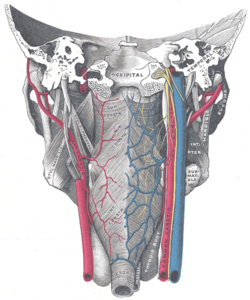Anatomy and Components
- The pharyngeal plexus is located on the outer surface of the pharynx.
- It contains a motor component derived from the vagus nerve (cranial nerve X).
- It also contains a sensory component derived from the glossopharyngeal nerve (cranial nerve IX).
- The sympathetic component of the plexus is derived from the superior cervical ganglion.
- The plexus provides motor innervation to most muscles of the soft palate and most muscles of the pharynx.
Afferents
- Motor component: pharyngeal branch of the vagus nerve (CN X) with neuron cell bodies in the nucleus ambiguus.
- Sensory component: pharyngeal branches of the glossopharyngeal nerve (CN IX).
- Sympathetic vasomotor component: efferent fibers of the superior cervical ganglion.
- The cranial part of the accessory nerve (CN XI) is sometimes considered part of the pharyngeal plexus.
- The pharyngeal branch of the vagus nerve ramifies upon reaching the superior border of the middle pharyngeal constrictor muscle.
Efferents/Distribution
- Outgoing fibers from the pharyngeal plexus ascend or descend upon the superior and inferior pharyngeal constrictor muscles.
- The fibers then ramify within the pharyngeal muscular layer and mucous membrane.
- Motor innervation from the pharyngeal plexus includes all muscles of the pharynx except the stylopharyngeus muscle.
- The muscles innervated by the pharyngeal plexus include palatopharyngeus, palatoglossus, musculus uvulae, and the pharyngeal constrictors.
- The stylopharyngeus muscle is directly innervated by a branch of the glossopharyngeal nerve (CN IX).
Sensory
- The pharyngeal plexus provides sensory innervation to most of the pharynx.
- It provides sensory innervation to the oropharynx and laryngopharynx from CN IX and CN X.
- The nasopharynx above the pharyngotympanic tube and the torus tubarius is innervated by CN V.
- Specific sensory components of the pharyngeal plexus are responsible for sensory perception in different regions of the pharynx.
- Further citation is needed to support the sensory innervation details.
Related Concepts
- Superior cervical ganglion is related to the pharyngeal plexus.
- Understanding the role of the superior cervical ganglion can provide additional insights into the function of the pharyngeal plexus.
- Exploring the relationship between the pharyngeal plexus and other anatomical structures can enhance understanding of its functions.
- Further research and study on the superior cervical ganglion and its relationship with the pharyngeal plexus can contribute to a comprehensive understanding of this topic.
- Additional information on the superior cervical ganglion can provide a broader context for understanding the pharyngeal plexus.
The pharyngeal plexus is a nerve plexus located upon the outer surface of the pharynx. It contains a motor component (derived from the vagus nerve (cranial nerve X)), a sensory component (derived from the glossopharyngeal nerve (cranial nerve IX)), and sympathetic component (derived from the superior cervical ganglion).
| Pharyngeal plexus of vagus nerves | |
|---|---|
 Muscles of the pharynx, viewed from behind, together with the associated vessels and nerves. (Pharyngeal plexus visible but not labeled.) | |
| Details | |
| Identifiers | |
| Latin | plexus pharyngeus nervi vagi |
| TA98 | A14.2.01.159 |
| TA2 | 6338 |
| FMA | 6236 |
| Anatomical terms of neuroanatomy | |
The plexus provides motor innervation to most muscles of the soft palate (all but the tensor veli palatini muscle) and most muscles of the pharynx (all but the stylopharyngeus muscle). The larynx meanwhile receives motor innervation from the vagus nerve (CN X) via its external branch of the superior laryngeal nerve and its recurrent laryngeal nerve, and not through the pharyngeal plexus.[citation needed]